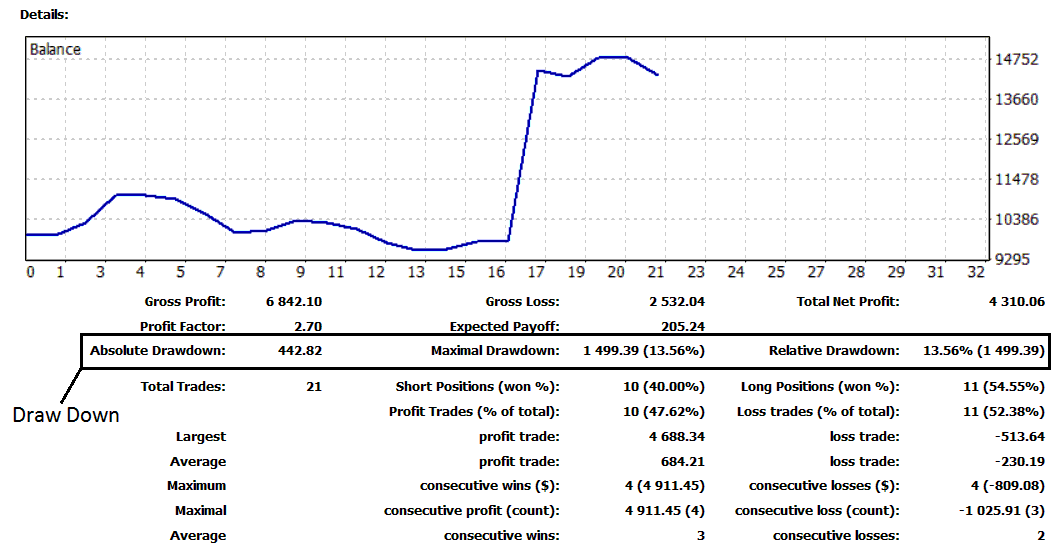Draw-Down & Max Draw-down
To profit in business, traders must handle risks well. Learn equity management methods for BTCUSD from this Bitcoin tutorial site.
In trading, the risks to manage encompass possible trading losses. Adhering to money management guidelines not only safeguards your account but also enhances your profitability in the long term.
Draw-down
Foremost among risks for traders is what is known as draw-down - this quantifies the monetary reduction experienced in one's cryptocurrency account resulting from a single bitcoin trade loss.
If your trading capital totals $10,000 and a single trade position results in a $500 loss, your calculated draw-down amounts to $500 divided by $10,000, which equates to a 5 percent draw-down.
Maximum Draw-down
This quantifies the total monetary value lost within your cryptocurrency account prior to achieving a net positive performance. For example, if your starting capital is $10,000, and you experience five consecutive losing trades accumulating a total loss of $1,500, followed by ten winning trades generating a total profit of $4,000, the resulting maximum drawdown is calculated as $1,500 divided by the initial $10,000, yielding 15% drawdown.

Draw-Down is $442.82 (4.40%)
Maximum Draw Down is $1,499.39 (13.56%)
To learn how to create and obtain the trading reports mentioned above using the MetaTrader 4 platform, please refer to the lesson guide on generating reports on MT4.
Bitcoin Trade Equity Management
The example below shows how it's different to risk a small part of your trading money compared to risking a larger part. Good investing means you shouldn't risk more than 2% of all your money.
% Risk Technique

2 percent & 10 percent Risk Rule
Risking two percent of your equity differs a lot from risking ten percent on one trade.
If you had a bad run and lost 20 trades in a row, and you risked 10% on each trade, your starting balance of $50,000 would drop to just $6,750 left in your account. That means you would have lost more than 87.50% of your money.
However, if you risked only 2 % you would have still had $34,055 which is only a 32% loss of your total equity. This is why it's best to use the 2 % risk management strategy
Difference between risking 2% & 10 % is that if you risked 2% you'd still have $34,055 dollars after 20 losing trade transactions.
However, if you risked 10 % you would only have $32,805 after only 5 losing trade positions that's less than what you'd have if you risked only 2 % of your account and lost all 20 trade positions.
The key thing is that you, as someone who trades, should create your rules so that even if you experience a period of losses, you still have enough money available to trade in the future.
Should you lose 87.50% of your funds, you would have to gain 640 % to get back to the point where you started even.
As compared and analyzed to if you lost 32% of your trading capital you'd have to make 47 % profit just to go back to break-even. To compare and analyze it with the illustrations 47 % is a lot easier to break-even than 640% is.
Chart below shows what percent you'd have to make to get back to break even if you were to lose a certain percentage of your capital.
Concept of Break-Even

Account Equity & Break Even
If you lose 50% of your money, you need to make 100% of what's left – very few traders can do this – to just get back to where you started with the amount they had initially.
At 80% draw-down, one must quadruple their equity just to bring and take it back to its starting equity. This is what is called to "break-even" i.e. Get back to your original account balance which you deposited.
The greater the you lose, the harder it's to make it back to your initial trading account size.
This is the rationale behind why, as a BTC/USD trader, it is imperative to take all necessary measures to safeguard your equity. You should not permit yourself to incur a loss exceeding 2 percent of your equity on any single trade position.
Bitcoin risk management means risking just a small part of your funds per trade. This way, you handle losing runs without big account drops.
In BTCUSD Cryptocurrency, traders use stop loss cryptocurrency orders which are put in order and so as to minimize losses. Controlling risks it involves putting a stop loss bitcoin order after setting an order.
Effective Risk Management
To manage risks effectively, one must keep all risks under control. It is essential to establish a clear bitcoin trading money management system and a solid trading plan. Engaging in Bitcoin or any business requires making choices that come with inherent risks. Every aspect should be evaluated to minimize risk, utilizing the recommendations provided in this guide.
Learn More Courses and Topics:
- How Can You Analyze/Interpret a BTC/USD Symbol in MT4 Software Platform?
- How Can You Analyze/Interpret a BTC/USD Symbol in MT4 Software Platform?
- 3 Types of Stochastic Oscillators BTC USD Strategies
- MT4 BTCUSD Platform Show Tool Bar
- Technical BTC USD Technical Indicators Described Tutorial Lesson
- BTC USD Trendline Break Analysis Methods
- Can You Trade With MT4 Platform?
- Stochastic Divergence Setup Bitcoin Strategies
- How Can I Use Fib Pullback Levels for Day Trade BTCUSD?
- How to Trade Bar Charts
